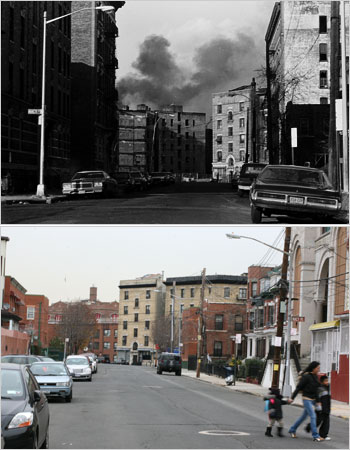Contested spaces
two interesting articles from the New York Times, "As Orthodox Population Grows, So Do Tensions," and "No Longer the City of ‘Bonfire’ in Flames." From the latter article:
The mostly black and Latino residents of Melrose, survivors of the “Bronx is burning” decades, now worry, not unlike suburbanites, about an influx of outsiders. They complain that the new Yankee Stadium, new malls and proposed congestion pricing could bring in out-of-towners from, say, Westchester to hog precious parking spaces. ...
“It becomes increasingly implausible for the Wall Street multimillionaire white folk living in $8 million Manhattan apartments to feel themselves oppressed by poor black people,” said Ronald L. Kuby, who was the partner of William Kunstler, the radical lawyer who died in 1995. Mr. Kunstler’s fictional counterpart helps Reverend Bacon portray Henry Lamb, the young man hit by Sherman’s Mercedes, as a sacrificial “honor student.”
"They have totally taken over Manhattan and are breaching the defenses of even remote parts of Harlem, are gentrifying the Bronx,” Mr. Kuby said of his fellow whites. “Far from fleeing, they are flooding in.”

Librado Romero/The New York Times; top, Joe ConzoChanges in the city in recent decades are illustrated by views of Hewitt Place in the Bronx around 1979, top, and today.
The problem is that the resurgence of cities is based in large part not by improving the economic lot of the people who had been living there during and after the period of suburban outmigration, but by becoming more attractive to people with greater economic means and greater choices.
Instead of seeing cities as cesspools, the perception changed to one that was positive.
But this creates tremendous unrest.
The classic debate in urban economic development is do you invest in people (education, workforce development) or infrastructure and other capital-based investments? The problem with investing to great extent in people is that they move... and another problem is the amount of money required to bring people up to and beyond the median is tremendous, without any guarantee of success.
Now I haven't read this paper, by GWU sociology professors Gregory D. Squires and Charis E. Kubrin. "Privileged Places: Race, Uneven Development, and the Geography of Opportunity in Urban America," Urban Studies 42, (1): 47-68. 2005, but it is on my reading list.
From Revitalizing Washington's Neighborhoods: A Vision Takes Shape, by Alice Rivlin, Brookings Institution:
"New commercial development is transforming the central business district, after long stagnation. Restaurants, arts and entertainment, and new housing are appearing constantly. And the changes occurring downtown will only accelerate now that the new convention center has opened for business, and once convention hotels are built, the museum of news (Newseum) becomes a reality, and other projects currently underway are completed. Yet the changes downtown are just part of the story. Now, Washington needs to turn its attention to the future of its residential neighborhoods."
"Such highly visible revival in some neighborhoods has aroused excitement and renewed hope for the future of the city. Rising property tax revenues have helped the city balance its budget and pay for better services. But economic development also has downsides, which have aroused anxiety, apprehension, and racial or ethnic tensions. Middle-income households face higher shelter costs. Low-income residents fear that rising rents and property taxes will force them out of their homes. And older, settled communities worry they will lose the familiar character of their neighborhoods as new residents and businesses move in."Revival of the city has the potential to benefit all of the city’s racial, ethnic and income groups, but only if policies are adopted to ensure that these benefits occur. At present, neighborhood development is uneven, and the higher housing costs it generates are making life harder for the city’s low income population.
Hence the double challenge now facing District policymakers. Urgently they must consider:
■ How to keep the city’s revival going while spreading the benefits to more parts of the city
■ How to protect the low-income population against rising housing costs and ensuring that the city’s development leads to better services and job opportunities for all parts of the population
Labels: contested spaces, economic development, invasion-succession theory, urban revitalization, urban sociology



0 Comments:
Post a Comment
<< Home